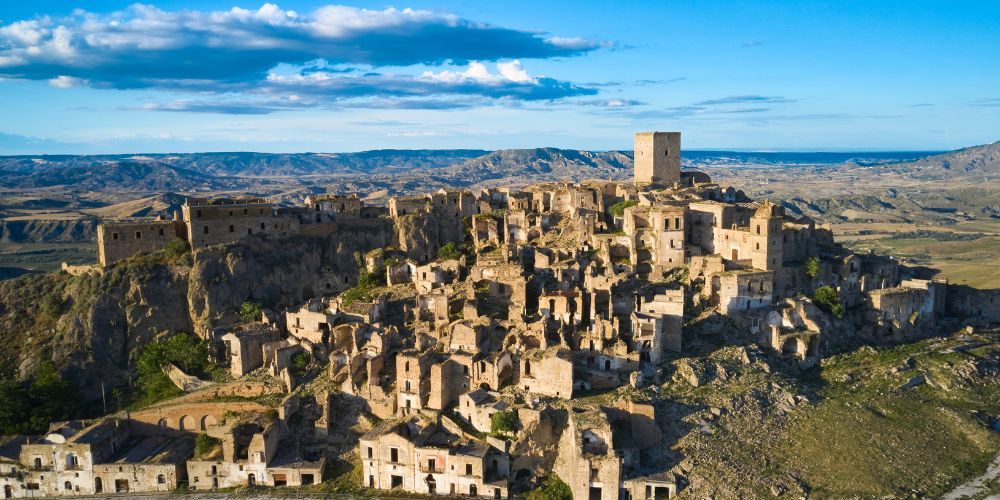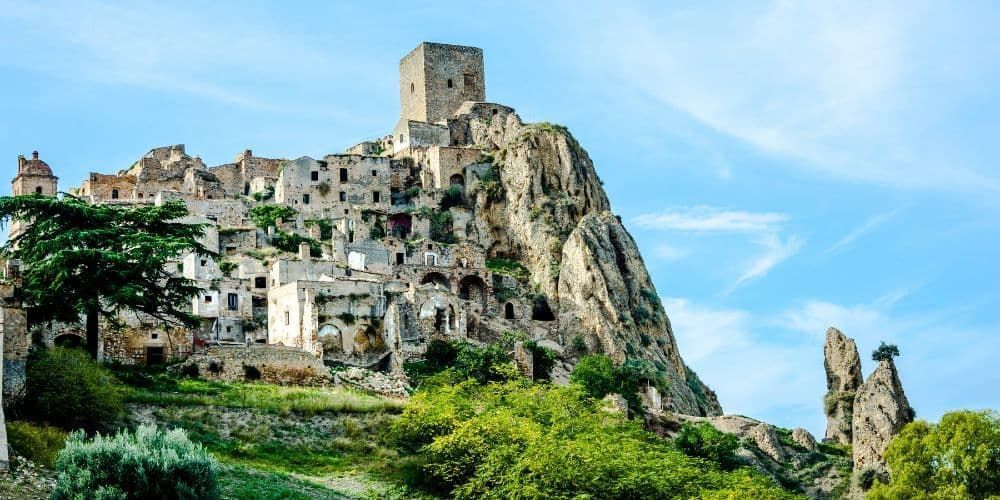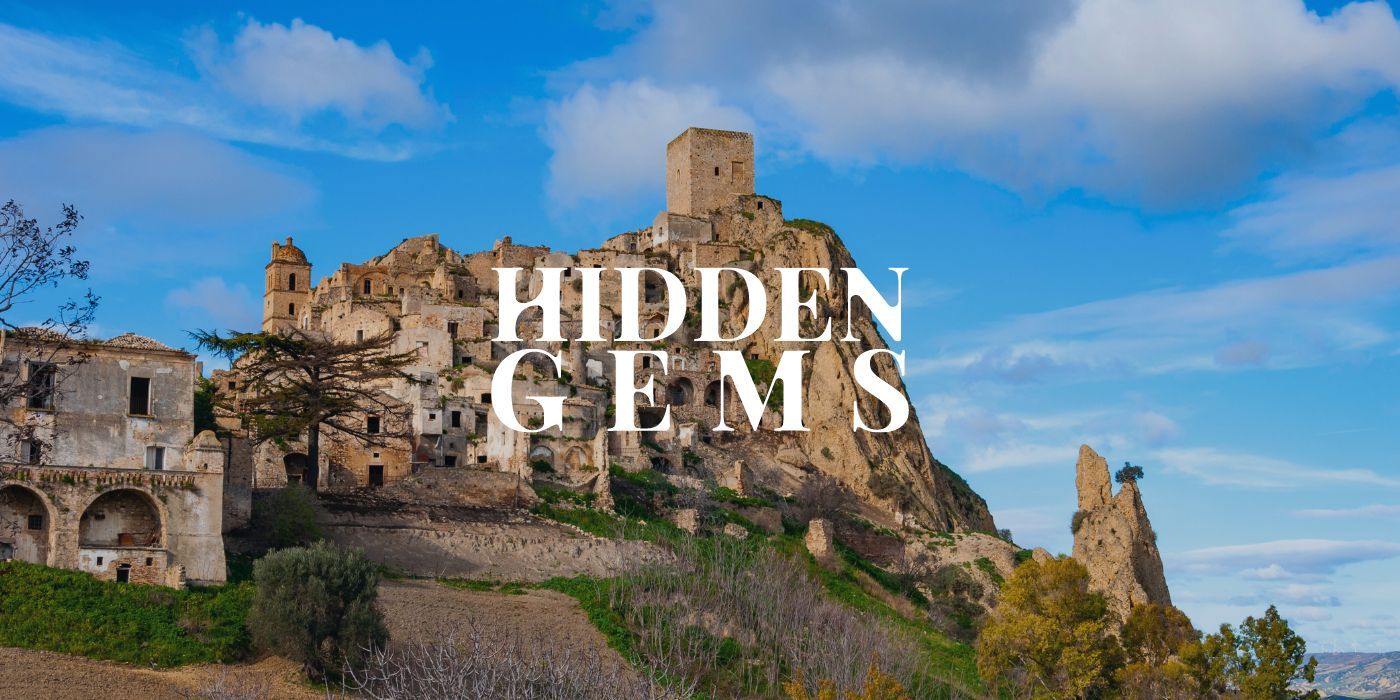In the middle of Basilicata, perched on a rocky hill where the characteristic calanchi stand out, that are deep furrows in the ground along the slope of the hill, and surrounded by a vast countryside dotted with olive trees, here lies the picturesque ghost town of Craco.
That's right, today our journey takes us to this village that has been forsaken for more than half a century, which for all these years has remained left as it was to its own history and the wild nature of this territory. Get ready for a unique experience, between awesomeness and curiosity, and discover Craco with us on your adventure in Lucania!

Craco: where it is and how to get there

We are in the southernmost area of Basilicata, about 50 km south of Matera, in a hilly territory embraced between the Lucanian Apennines and the Ionian Sea. Immersed in this landscape as wild as fascinating, Craco stands on the top of a cliff from which it overlooks the surrounding panorama from its almost 400 meters above sea level, an atmosphere of silent and almost unintelligible beauty.
To better understand the features of this particular and evocative place, we recommend that you carefully read the emotional history of this ghost town in the following paragraph.
However, let's first find out how to get to Craco.
Craco is easily reachable by car starting from the main cities of southern Italy, considered as one of the best tourist destinations by motorcyclists. Following, here are the two main (and simplest) routes to reach the ghost town of Basilicata.
From the A2 Mediterranean Highway (or Salerno-Reggio Calabria), take the exit for Sicignano continuing towards Potenza; subsequently, drive to the SS 407 Basentana towards Metaponto and continue from the Pisticci exit following the signs for Craco on the provincial roads.
Alternatively, driving along the SS 106 Jonica (or Taranto-Reggio Calabria), take the exit at Metaponto and proceed on the SS 407 Basentana; as before, in this case go on from the Pisticci exit following the signs for Craco, too.
Buy here your Matera PassDiscover Craco: a bit of history of the ghost town in Basilicata

Here we are, finally arrived in the most famous ghost town in the South, one of the most beautiful villages in Basilicata and a cultural and tourist jewel in the province of Matera! At this point, you are surely wondering what happened and above all what to see in Craco. If you agree, let's find out together right away!
What happened to Craco? In this Lucanian village everything changed in 1963, following a terrible landslide which made collapse the clay subsoil of its historic center. This disastrous event was partially due to the particular morphology and geology of the territory, consisting of a clayey and irregular ground undermined by the waters below, and partially to human activity, which further increased the risk related to the flow of water underground with the excavation of numerous wells and cisterns.
Before the landslide, Craco was known as "city of wheat" because in the valleys surrounding its rocky cliff countless fields of this cereal were cultivated. It is no coincidence that on the coat of arms of Craco appear three spikes of wheat held firmly by a human arm, a symbol of the strength and firmness of the agricultural culture of Basilicata.
After the landslide, life went on with the gradual movement of the inhabitants of Craco to the nearest town of Peschiera, which became the municipal seat; a process of depopulation made even more inevitable by two other natural disasters, that are the flood in 1972 and the Irpinia earthquake in 1980, following which Craco was completely abandoned and turned into a ghost town.
What to see in Craco? Since 2009 the local administration has taken steps to recover the old village to relaunch it internationally as a tourist, landscape and cultural destination. In 2010 Craco was included in the World Monuments Fund's list of monuments to be preserved, while between 2011 and 2012 was developed a guided tour to visit the ancient ghost town safely.
In the next paragraph, let's see in detail the main points of interest to admire in Craco!
Discover Craco: visit the historic centre of the ghost town

Well, the time has come discover Craco on the guided tour of the ghost town. First of all, it is necessary to remember that the ancient origins of this village, dating back even to the 8th century BC; however, the most important and authentic sources come from the Middle Ages, which report about the feud of Cracum, dating back to 1164, characterized by a squared tower - the Norman Tower - which still today, despite all that happened, stands out in the skies of the province of Matera.
Over the centuries, Craco has passed under the power of many different feudal lords, and this explains the presence of many noble residences among the historic buildings of the ghost town, such as Palazzo Maronna, Palazzo Grossi, Palazzo Carbone, Palazzo Simonetti and Palazzo Cammarota Rigirone.
Among the stops not to be missed there’s is above all the 1600s’ Church of San Nicola, which just like with the tower stands out in the landscape of Craco for its bell tower built on three levels and embellished with a dome decorated with majolica; on the inside, have remained intact some beautiful frescoes and altars, works of sacred art inspired above all by the Neapolitan school.
Today some of the ghost town's buildings have been renovated and converted into places of culture. An example is given by the former monastery of San Pietro, also from the 1600s, which survived the landslide of the ‘60s without too much damage and now houses the Emotional Museum of Craco. Here it is possible to learn about the history of Craco over the centuries, through cultural events, presentations, screenings, scenographic installations and photographic exhibitions regarding many films that were shot in Craco.
Yes, the emotional and forgotten beauty of Craco has been a source of inspiration for professionals of Italian and international cinema, so much so that it was chosen as a location for some successful films such as The Passion of the Christ by Mel Gibson, Quantum of Solace from the 007 saga starring the legendary James Bond, and Basilicata Coast to Coast by Rocco Papaleo.
How to visit Craco? If you want to visit the historic center of the ghost town, exploring its ruins and the spectacular landscape of the calanchi, you will have to rely on one of the guided tours offered by the municipal organization. The tourist route lasts about an hour and a half and must be undertaken with protective helmets and clothing suitable for hiking and outdoor explorations.
Craco: enjoy your trip to Basilicata and in the province of Matera

Do you want new tourist adventures around Lucania? We have the right solutions for you! Take a look at our guide dedicated to unmissable places to see in Basilicata discovering the most beautiful stops to include in your next tour.
If you are looking for a truly compelling experience in this region of wild charm, we instead propose you this fantastic itinerary for a road trip in Basilicata which, among other stages, will take you right to the ghost town of Craco. If you feel like adding an extra stop, take a look at the enchanting Rotondella, the balcony over the Ionian Sea.
To end the journey with a bang, we return to the evocative setting of Matera, a place acknowledged as UNESCO world heritage site, European capital of culture in 2019 and probably the oldest continuously inhabited city on Earth: click the button below to find out how to best experience it with a guided walking tour through its wonders!
Book now your guided walking tour in MateraAbout the author
Written on 07/04/2024



Massimiliano Antonio Primi
A trip to Basilicata? Discover Craco, the evocative and picturesque ghost town in the province of Matera where everything changed in the '60s...